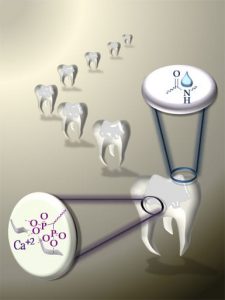Recent advances in dental materials have taken vast steps from the old denture and bridge days, seeing composite fillings replace mercury-containing amalgam, as well as realistic looking veneers and implants. But the most important part of any restoration—the dental adhesives—remain its weak point.
Modern ‘self-etching’ dental adhesives actually etch the enamel and dentin of the tooth to create a strong bond between composites and dental tissues. The main problem of modern dental adhesives is that, because water is an important ingredient in the adhesive itself, they can break down from constant exposure to the wet environment of the human mouth.
However, researchers at Turkey’s Bogazici University led by Dr. Duygu Avci created a new form of dental adhesive that both improves the ability to etch enamel and dentin and increases its stability in water. According to a report published in the Journal of Polymer Science Part A: Polymer Chemistry, the research team tested four new monomers which contained either a bisphosphonate or a bisphosponic acid; the first two are bismethacrylamides, and the second group are methacrylamides.
“We feel that both improved quality and improved durability, on the shelf and in the restored tooth tissue, has been achieved,” said Dr. Avci.
However, bisphosphonates, which can be taken to treat cancer, osteoporosis, and other conditions, have been associated with osteonecrosis of the jaw (ONJ), in which the jaw bone begins to die due to a disruption in its blood supply. The authors report that the amount of bisphosphonates contained in the adhesive are comparable to or less than that contained in a single dose of medication. Dental fillings are applied much less often than regular doses of medication, and so the risk of ONJ due to these monomers, if any, should be very low.
“Furthermore, the use of dental adhesives involves quick polymerization by its very nature, and polymers will not diffuse to travel elsewhere in the body,” said Dr. Avci. “The amount of residual monomers left behind will naturally be lower than the initial amount used.”
In continuing this research, the team plans to synthesize more of the same family of monomers by varying the structure, hoping to further improve the durability of the material. Dental fillings with improved lifetimes and dental materials with increased shelf-life may the result, offering dentistry a new way to strengthen itself.


















